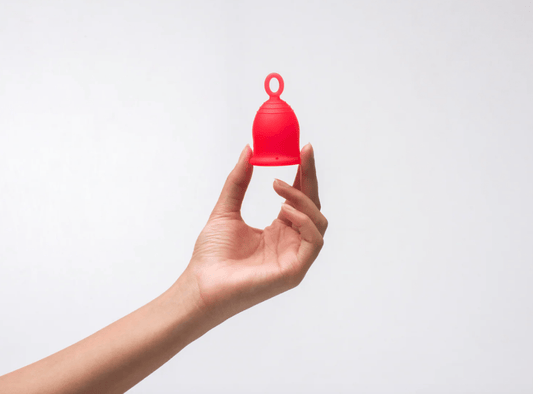 How many of you have tried inserting your menstrual cup upwards instead of at a 45 degree angle?
How many of you have tried inserting your menstrual cup upwards instead of at a 45 degree angle?
This is a common perception as it’s what we’ve been taught in biology reproductive diagrams.
The majority of female reproductive educational models and materials show the uterus, the cervix, and the vagina, vertically placed on top of each other. That is not 100% accurate.
It is important to know that the vaginal canal is not vertically placed within our pelvic floor - but rather it is angled slightly towards our lower-back or tailbone. And at top of the vaginal canal is the cervix - which is a tiny opening that’s often referred to as the neck of the uterus.
Just how we all look different externally; born with distinctive features and physical traits - the same is the case for our internal organs.
So in this blog, let’s explore a little bit about our reproductive anatomy.
What is a uterus?
Did you know that the position of the uterus can be different for everyone?
You can imagine your uterus as a ‘light bulb’ which lies in between your bladder and rectum. It is generally the size of your fist, covering around 3 inches from the top to bottom and is 2 inches in width.
It’s like a stretchable muscular bag which expands and contracts during menstruation and childbirth.
 What are the different positions of the uterus?
What are the different positions of the uterus?
The positioning of the uterus can vary from person to person. And it is not a matter of concern. It’s just unique!
In about 75% of women the uterus is either tipped towards the bladder (towards your belly) and lies over it, or is upright straight. This commonly found uterus position is called ‘anteverted uterus.’
And in 25% of women, the uterus takes a back seat, or is tipped backwards towards the spine (away from your belly).
This is what we call a tilted or retroverted uterus.
How do I know if I have a tilted uterus?
You won’t even know if you have a tilted or retroverted uterus because there are no specific symptoms or discomfort that you will face - simply because a tilted uterus is completely normal!
In fact many of us don't know the positioning of our uterus until childbirth or some sort of discomfort you may feel due to a health condition - which could lead to a diagnose of tilted cervix.
What causes a tilted or retroverted uterus?
The reason for a tilted or retroverted uterus can be genetic for many people.
As a person’s body changes with age, for some people the uterus tilts forward while for others it stays tilted back.
In some people there could be various factors that can cause a tilted uterus such as:
- Weakened pelvic floor muscles
- Bulky or enlarged uterus
- Scarring of pelvic tissues
- Endometriosis
- Fibroids
- Pregnancy
 What is a tilted cervix?
What is a tilted cervix?
The base of the uterus is called the cervix.
The cervix also changes its position during different menstrual phases in your monthly cycle. Depending on which menstrual phase you are in, the cervix can change its position to high or low and vice-versa.
A tilted cervix means that the position of your cervix will be towards the front in your lower abdomen.
Can you use a menstrual cup with a tilted uterus or tilted cervix?
Many people have asked us, do menstrual cups work with a tilted uterus? Can I use a menstrual cup with a tilted cervix?
The answer is yes absolutely! You can use a menstrual cup if you have a retroverted or tilted uterus.
It is important to do your research and choose a high quality cup that is safe and comfortable.
The Asan cup is a high quality menstrual cup made from Class 6 Medical Grade Silicone, which is the same material used in heart stents and breast implants. It is super smooth and safe to sit inside you, no matter how tilted your uterus may be.
 The most important thing to remember is that the cup needs to be placed lower in your vaginal canal. You might have to experiment a bit and see which fold works best for you while managing your periods.
The most important thing to remember is that the cup needs to be placed lower in your vaginal canal. You might have to experiment a bit and see which fold works best for you while managing your periods.
As our sizing is based on your period flow, both sizes will be suitable for you regardless if you have a high cervix, low cervix or tilted cervix - making the Asan menstrual cup the best cup for a tilted cervix.
Asan’s unique removal ring design makes it hassle free while removal. As people with a tilted uterus or tilted cervix might have to wear their cup low, the ring does not poke or cause any discomfort even when it sticks out of your vagina.
You can watch this tutorial or read our detailed blog on chopping the ring off your menstrual cup if you would like to cut the ring. However please try the cup for a full cycle first as your cervix continues to change position during your period.
How do I insert a menstrual cup if I have a tilted uterus and tilted cervix?
If you have a tilted uterus and tilted cervix you should wear your menstrual cup a little lower. Make sure you do not push it too high.
The cup should sit below the cervix in the vaginal canal to catch your period flow. Read our blog on insertion to learn everything you need to know about inserting a menstrual cup.
Always make sure that you insert the cup towards your tailbone and not upwards. And to remove the cup just pinch the bottom of the cup to release the air suction and gently slide it out.

frequently asked questions
Are you born with a tilted uterus?
Yes, some people might be born with a tilted uterus. It also depends on various conditions too, such as, during pregnancy the uterus might shift its position. In other cases, health conditions like endometriosis, fibroids and cysts might lead to change in how a uterus is shaped as well as positioned.
Can you feel if you have a tilted uterus?
No, you cannot feel if you have a tilted uterus unless you experience severe symptoms such as:
- Painful sex
- Trouble inserting tampons or menstrual cups during periods
- susceptible to urinary tract infections and urinary incontinence
If you have these symptoms, you should see a doctor to conduct a pelvic examination or an ultrasound to help you.
Can you fix a tilted uterus?
There is no need to fix as tilted uterus as it is a completely normal condition.
If you are someone that experiences some pain due to this condition, pelvic floor exercises, uterine suspension, or uplift surgeries can help fix the tilt in your uterus.
Is having a tilted uterus painful?
No, having a tilted uterus not supposed to be painful.
As it is tilted towards your backside, you might experience some menstrual cramps and pain in your lower back during periods.
Can a tilted uterus lead to infertility?
Having a retroverted or tilted uterus has no relationship on fertility. People conceive naturally and have normal child births with this condition.
In fact, in most cases women don’t even know that they have a retroverted uterus.
The only time it can have an impact is if you have a condition like endometriosis or pelvic scarring.
Ready to shop for the best menstrual cup for a tilted uterus? Shop here now.






